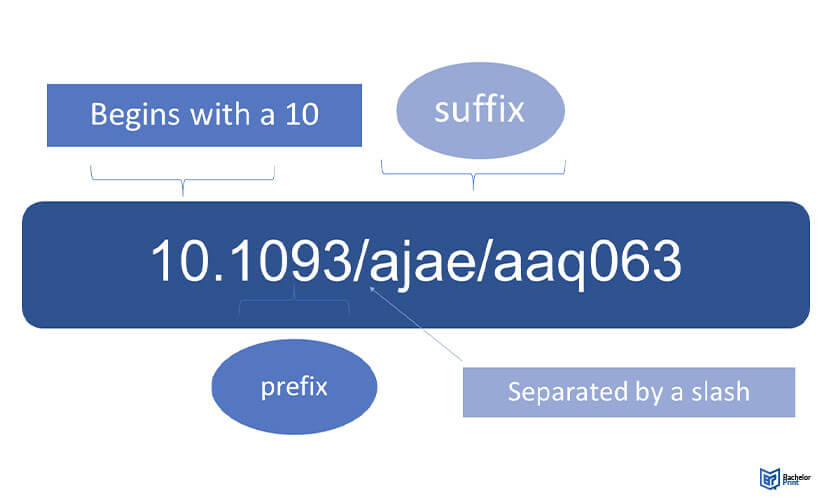
Digital Object Identifiers (DOIs) play a significant role in academic writing, especially when citing sources. These unique alphanumeric strings provide a persistent link to content online, ensuring that digital resources remain accessible even if their URL changes. The DOI is a code used to identify journal articles and other published works. It will allow your reader to locate the document you’ve cited. Consider it a Social Security number for the article you’re quoting; it will always and only refer to that specific piece.
Definition of DOI
Assigned by the International Organization for Standardization (ISO) Foundation, a Digital Object Identifier is a unique alphanumeric string that can identify information and establish a permanent connection to its location on the internet. When your work is published and made available online, the publisher issues a Digital Object Identifier to your piece.
Every Digital Object Identifier number begins with a 10 and consists of a prefix and a suffix separated by a slash. The suffix is supplied and designed by the publisher to be flexible in terms of publisher identification criteria: the prefix is a four or more digits unique number provided to organizations.

Locating the DOI
The Digital Object Identifier is almost always readily apparent when you access a journal article in an academic database. It is frequently listed close to the publication date and accompanied by “doi.org” or “DOI:”. If the database contains a “cite this article” button, this should generate a citation that includes the Digital Object Identifier.
If you can’t locate the Digital Object Identifier, you can search Crossref using information such as the author, paper title, and journal name. If you are still unable to find the paper in Crossref, it is safe to infer that it lacks a Digital Object Identifier.
Citing a DOI in APA style
| Digital Object Identifiers are placed after APA citations. They can be prefixed by the label "doi:" or formatted as URLs in the 6th edition of the APA publication manual: |
| APA 6th edition: doi:10.1177/0269881118806297 or https://doi.org/10.1177/0269881118806297 |
| Include the Digital Object Identifier in APA format (7th edition) for any works with one. Put it after your source, without a period. Create a hypertext link to the Digital Object Identifier using the format https://doi.org/. |
| Author, A. A., & Author, B. B. (Date of publication). Title of article. Title of Journal, volume number, page range. https://doi.org/10.0000/0000 |
Include only the Digital Object Identifier if your article contains both it and a URL.
Citing a DOI in MLA style
In MLA style citations, format a Digital Object Identifier as a hyperlink, beginning with
“https://doi.org/” followed by the article’s unique numerical identifier.
Since the most current (9th) edition of MLA, students are encouraged to incorporate the Digital Object Identifier at the end of the citation for a scholarly online journal article. If there is no Digital Object Identifier, use the URL.
Check with your instructor to see if they require you to include the date you obtained the article, even though MLA does not mandate this.
Citing a DOI in Chicago style
The majority of scholarly publishers now assign journal articles, e-books, and other publications a unique alphanumeric identifier known as a Digital Object Identifier. The Chicago style manual for referencing electronic sources requires that, whenever practicable, this number be included in the citation. The Digital Object Identifier is often located on the first page of scholarly journal publications and in the database record for the article.
FAQs
A Digital Object Identifier is a unique identifier for an electronic document. Academic citation relies on Digital Object Identifiers since they are more reliable than URLs in locating the source.
Although Digital Object Identifiers are becoming more widespread and frequently necessary, not all publications have or use them in database listings. An excellent technique to verify if the article has a Digital Object Identifier is by using a free search service supplied by one of its Registration Authorities, such as:
- CrossRef: Examines the articles’ metadata and provides search options by title, author, Digital Object Identifier, ORCID, etc.
- DataCite: Contains distinct search divisions (Works, People, Data Centers, and Members) that allow the user to do a more targeted search.
Digital Object Identifiers are persistent, meaning they are designed with the ability to provide lasting data on where one can find info or objects about them on the internet. Although the information on an object may change over time, such as where to find it, its Digital Object Identifier will never change.
Digital Object Identifiers:
- Aid in citation tracking, ensuring a researcher has accurate metrics on how and where their research outputs are being used or referenced.
- Increase data sharing and reuse by making information discoverable over the long term.
- Are required or strongly encouraged in specific citation style guidelines.
- They are becoming a critical part of the repository, journal, and database submission workflows.
